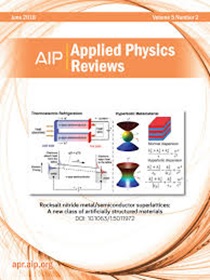推进纳米光学研究:金属和介电Mie粒子在SPM技术及其新兴应用
IF 11.6
1区 物理与天体物理
Q1 PHYSICS, APPLIED
引用次数: 0
摘要
入射光和纳米粒子(NPs)之间的米氏散射在改善光学和光子器件(如传感器、发光二极管和太阳能电池)的性能方面起着至关重要的作用。虽然传统的远场光谱和电磁模拟已被用于研究米氏散射,但这些方法缺乏真实空间成像能力,限制了它们捕捉单粒子散射现象的能力。基于扫描探针显微镜的纳米技术已经成为研究纳米尺度米氏散射的关键,以解决这一限制。本文综述了Mie散射的理论基础,以及近场显微镜在高分辨率成像中弥合理论与实验之间差距的作用。通过关注真实空间成像,我们强调了Mie散射的实际方面及其在生物传感、光催化和材料科学等领域的应用。纳米技术允许直接可视化纳米结构中的散射过程,为纳米粒子如何在纳米尺度上与光相互作用提供更深刻的见解。此外,我们讨论了人工智能(AI)增强近场分析的潜力,为Mie散射现象提供更准确的解释。综上所述,将先进的纳米技术与人工智能驱动的分析相结合,将极大地促进我们对Mie散射及其在各个科技领域的广泛应用的理解。尖端成像方法和计算模拟之间的协同作用不仅丰富了我们对散射现象的理论认识,而且加速了下一代光子器件的发展,为广泛的科学和技术领域的实际应用铺平了道路。本文章由计算机程序翻译,如有差异,请以英文原文为准。
Advancing nano-optical investigations: Metallic and dielectric Mie particles in SPM techniques and their emerging applications
Mie scattering between incident light and nanoparticles (NPs) plays a vital role in improving the performance of optical and photonic devices, such as sensors, light-emitting diodes, and solar cells. While traditional far-field spectroscopy and electromagnetic simulations have been used to study Mie scattering, these methods lack real-space imaging capabilities, limiting their ability to capture single-particle scattering phenomena. Scanning probe microscopy-based nanoscopy techniques have become essential for studying Mie scattering at the nanoscale to address this limitation. This review explores the theoretical foundations of Mie scattering and the role of near-field microscopy in bridging the gap between theory and experiment through high-resolution imaging. By focusing on real-space imaging, we highlight the practical aspects of Mie scattering and its applications in fields such as biosensing, photocatalysis, and materials science. Nanoscopy techniques allow for direct visualization of scattering processes in nanostructures, offering more profound insights into how NPs interact with light at the nanoscale. Additionally, we discuss the potential of artificial intelligence (AI) to enhance near-field analysis, providing more accurate interpretations of Mie scattering phenomena. In conclusion, combining advanced nanoscopy and AI-driven analysis will significantly advance our understanding of Mie scattering and its diverse applications in various scientific and technological fields. The synergy between cutting-edge imaging methods and computational simulation not only enriches our theoretical understanding of scattering phenomena but also accelerates the development of next-generation photonic devices, paving the way for a wide range of practical applications across scientific and technological domains.
求助全文
通过发布文献求助,成功后即可免费获取论文全文。
去求助
来源期刊

Applied physics reviews
PHYSICS, APPLIED-
CiteScore
22.50
自引率
2.00%
发文量
113
审稿时长
2 months
期刊介绍:
Applied Physics Reviews (APR) is a journal featuring articles on critical topics in experimental or theoretical research in applied physics and applications of physics to other scientific and engineering branches. The publication includes two main types of articles:
Original Research: These articles report on high-quality, novel research studies that are of significant interest to the applied physics community.
Reviews: Review articles in APR can either be authoritative and comprehensive assessments of established areas of applied physics or short, timely reviews of recent advances in established fields or emerging areas of applied physics.
 求助内容:
求助内容: 应助结果提醒方式:
应助结果提醒方式:


